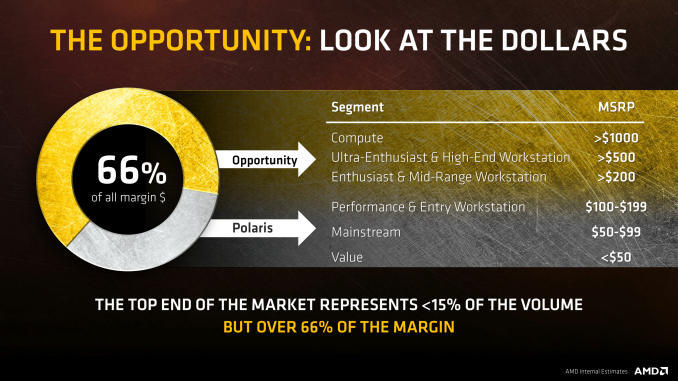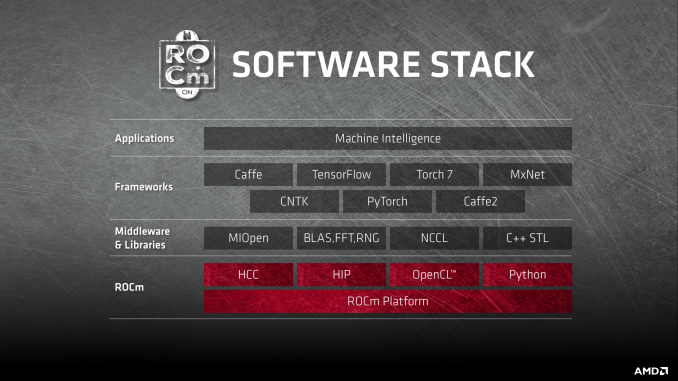AMD Unveils the Radeon Vega Frontier Edition: Vega Starts in the Pros
by Ryan Smith on May 17, 2017 2:45 AM EST- Posted in
- GPUs
- AMD
- Radeon
- Machine Learning
- Vega
- Radeon Pro
- Vega Frontier Edition
Vega Frontier Edition’s Target Market: AI, Machine Learning, and other Professionals
As important as the Vega hardware itself is, for AMD the target market for the hardware is equally important if not more. Vega’s the first new high-end GPU from the company in two years, and it comes at a time when GPU sales are booming.
Advances in machine learning have made GPUs the hottest computational peripheral since the x87 floating point co-processor, and unfortunately for AMD, they’ve largely missed the boat on this. Competitor NVIDIA has vastly grown their datacenter business over just the last year on the back of machine learning, thanks in large part to the task-optimized capabilities of the Pascal architecture. And most importantly of all, these machine learning accelerators have been highly profitable, fetching high margins even when the cards are readily available.
For AMD then, Vega is their chance to finally break into the machine learning market in a big way. The GPU isn’t just a high-end competitor, but it offers high performance FP16 and INT8 modes that earlier AMD GPU architectures lacked, and those modes are in turn immensely beneficial to machine learning performance. As a result, for the Vega Frontier Edition launch, AMD is taking a page from the NVIDIA playbook: rather than starting off the Vega generation with consumer cards, they’re going to launch with professional cards for the workstation market.
To be sure, the Radeon Vega Frontier Edition is not officially branded as a Pro or WX series card. But in terms of AMD’s target market, it’s unambiguously a professional card. The product page is hosted on the pro graphics section of AMD’s website, the marketing material is all about professional uses, and AMD even goes so far as to tell gamers to hold off for cheaper gaming cards later on in their official blog post. Consequently the Vega FE is about the closest analogue AMD has to NVIDIA’s Titan series cards, which although are gaming capable, in the last generation they have become almost exclusively professional focused.
AMD launching a new GPU architecture in the professional space first is a very big deal. Simply put, the company has never done it before. Fiji, Hawaii, Tahiti, Cayman, Cypress, and more all launched in consumer cards first. The traditional wisdom here is that launching in the consumer space first allows consumers to get their hands on the cards now, while professional products undergo further validation and refinement to meet the higher standards of professional users. Put another way, consumers serve as the final layer of debugging a new GPU, offering mass testing unlike anything else. So for AMD to launch in the pro market first indicates that they have an extensive amount of faith in the product.
As for why AMD would want to do this, the following AMD slide says it all.
Simply put, professional cards sell for higher prices than consumer gaming cards, sometimes significantly higher. As a result it makes all the sense in the world to sell their first Vega cards to professional users who are willing to pay $1000+ for a compute card, as opposed to consumers who would like to pay half that. More than anything else, AMD’s overall lack of profitability has come from a lack of high-margin parts to help offset their ongoing operational costs, and launching Vega as a pro card is one of the steps AMD is taking to correct that.
For pro users then with sufficiently deep pockets, they’ll be the first to get a crack at AMD’s latest high-end video card/accelerator. AMD calls this line of cards the Frontier Edition, and while the name is clearly AMD being cheeky towards NVIDIA’s Founder’s Edition line, the analogy isn’t completely off-base. AMD’s target market is going to be machine learning developers, game developers, and others who AMD believes need early access to the cards for future development. The advantage of this route is that, particularly in the case of machine learning, this allows developers to get a jump on testing a new architecture ahead of placing a large order for server cards. So in a sense, one of the roles of the Vega FE is to prime the pump for selling Radeon Instinct MI25 cards later in the year.
As for consumers, while this is as big a change for them as it is for AMD, it’s likely a hallmark of what to expect in the future for new high-end GPU launches. For AMD gamers who have been holding out for Vega, it’s clear that they’ll have to hold out a bit longer. AMD is developing traditional consumer gaming cards as well, but by asking gamers to hold off a little while longer when the Vega FE already isn’t launching until late June, AMD is signaling that we shouldn’t be expecting consumer cards until the second half of the year.
Wrapping things up, it’ll be very interesting to see how this strategy goes for AMD. NVIDIA has been very successful in the machine learning market over the last year, and if AMD can replicate NVIDIA’s success, not only will they make the machine learning market far more competitive for everyone, but they also stand a very good chance of finally turning the corner on both profitability and their overall share of the HPC market.













134 Comments
View All Comments
roc1 - Wednesday, May 17, 2017 - link
Going workstation first appears provoked by insufficient supply or inability to compete in terms of performance per dollar.I really wish AMD had more objective slides and comparisons in their slides.
xype - Wednesday, May 17, 2017 - link
Newsflash: Not everything is a conspiracy.Workstation = big margins. That’s what AMD needs, more income. As a business decision it’s the only thing that makes sense.
JKay6969AT - Wednesday, May 17, 2017 - link
I would tend to agree that AMD's choice to go workstation first is most likely being led by supply issues with HBM2 I would disagree that it is anything to do with performance per dollar, in fact I would presume the opposite as the pro market is already dominated by nVidia and AMD would be competing directly with them to gain market share, they can't really accomplish this with poor performing cards in comparison with nVidia unless they plan to add a value sector to the pro market which is unlikely due to this being a very profitable sector and if there is one thing AMD needs more than anything right now it's profits and lots of them.I imagine desktop VEGA to compete in performance with the 1070, 1080 and 1080Ti while costing a bit less but the issue I have there is that of RAM or Cache size on the VEGA parts. I imagine that VEGA will launch in 4GB and 8GB varieties with HBM2 and while 8GB is plenty of RAM, comparing it to the 11GB in the 1080Ti will affect people's decision on which card to get, I know far too many people who would buy a worse GPU because it had more RAM, 'cause more is better right? LMAO!
I imagine this is part of the reason why AMD is showing how VEGA is able to run well with 2GB RAM with the High Speed Cache Controller enabled as it will help alleviate fears that 8GB isn't enough RAM or Cache. I also get why they call it cache, It reminds me of the old Pentium 2 Single Edge Contact Cartridge or SECC design which was inserted into Slot-1 Motherboards. The reason the CPU had the Slot form factor was because the cache chips were on the daughter board around the CPU rather than in later designs built right into the CPU itself. This is a very similar design strategy and should offer comparable speed benefits. I just look towards the next evolution of this process which should be the cache being baked into the GPU itself, there are issues with that as HBM memory is multi-layered and I imagine this would present significant design issues to incorporate this into the core of a GPU but hey, I'm a dreamer :-)
atragorn - Tuesday, May 23, 2017 - link
Actually the reason they went with slot-1 was to prevent AMD from sharing a socket with them.Super socket 7 was very good for AMD , external cache was the way it was done up to that point.
The K6-2 and K6-3 were clocking at 500mhz plus on socket 7.
The k6-3 was a beast with that extra cache but most people only saw it wasn't clocking as high and didnt realize the performance it offered.
Kvaern1 - Wednesday, May 17, 2017 - link
Volta wants a word with you.lefty2 - Wednesday, May 17, 2017 - link
You forgot to mention that Vega was 50% faster than P100 in Deep Bench.nevcairiel - Wednesday, May 17, 2017 - link
If any comparison would be meaningful, that would be to a Tesla V100, beating the competitors last years product a year later should be a given.lefty2 - Wednesday, May 17, 2017 - link
except that V100 isn't available til Augustcap87 - Wednesday, May 17, 2017 - link
It'll be over a year since the P100 is released and only a month after the VEGA FE that the V100 is released. It should be compared against the more recent one.Meteor2 - Wednesday, May 17, 2017 - link
Nobody outside the DOE will be buying V100s this year.